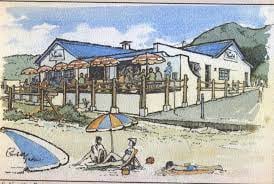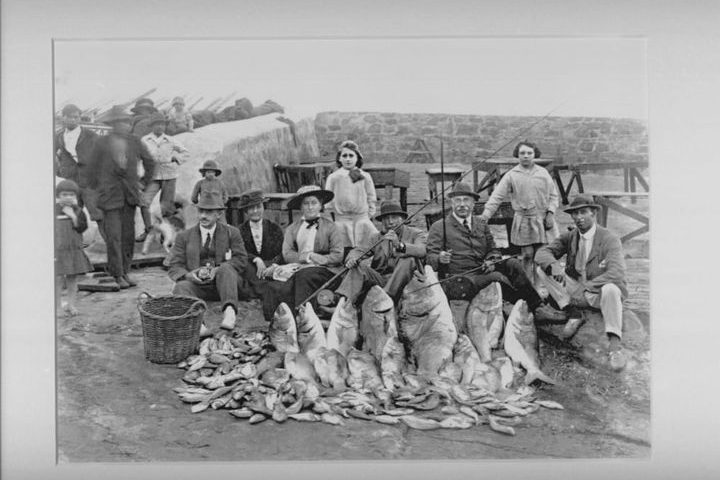
CHRISTMAS AT THE MARINE HOTEL, HERMANUS: 1945
January 19, 2022
THE GOLDFISH CAFÉ AT GROTTO BEACH(also known as the Driftwood Den and Nautilus):
January 19, 2022In the early 20th century, Hermanus became famous for another kind of ‘fishing’, which also had economic consequences. More accurately, it is referred to as ‘angling.’ Angling involved another level of society, being practised by middle- and upper-class males. Angling meant individual fishermen, not crews. They fished off the rocks or from a hired boat, catching large fish ‘personally’ with a single rod, not handlines. Angling was the recreation offered by Hermanus to busy diplomats, bureaucrats and even members of the aristocracy, such as the Earl of Athlone and his wife, Princess Alice.
Usually, the individual angler only participated when the catch was reeled in. Even at this stage, he might be assisted by a local fisherman referred to as a ‘ghillie’, who did all the dirty work: digging bait, baiting hooks, casting, gaffing, and killing the fish. The angler took all the credit.
He was much more prosperous than any handline fisherman. He could afford expensive imported equipment and tuition in fishing from the local ‘professional’, Bill Selkirk, a resident famous for his exploits in catching sharks of world-record size. He tutored anglers in the basics of the pastime and sold them tackle from his shop near the Marine Hotel.
Impressive specimens were weighed and individual records kept at the hotel where the angler was staying. The hotel chef would also prepare the trophy according to the angler’s wishes. It would be consumed in a convivial gathering with other guests, accompanied by traditional tales of the one that got away.
Berdine Luyt describes just such an incident at the Marine Hotel in the 1940s:
(Judge) Reggie Davis caught a large kabeljou a few days ago; it was a record catch. He was delighted and decided to have his photograph taken with the fish. It was relatively late in the afternoon when he returned to the hotel, but Mother sent one of the office staff on a bicycle to Mr Ravenscroft (the local photographer). Mr Ravenscroft sent back word that he couldn’t come until the next day, as it was time for his daily walk. No persuasion would make him alter his mind. So Reggie took the fish to the ‘vishok’ (fish-room) outside the kitchen, where it was hung, instructing the kitchen staff not to touch it.
The next morning, a kitchen staff member came to the office in tears. ‘An awful thing has happened, Mrs Luyt’, she said. ‘[Name] has cleaned Judge Davis’ kabeljou. ‘What are we going to do? I daren’t tell him. The man who normally cleans the fish was off duty when Reggie brought his kabeljou in, and the other kitchen staff, being busy at the time, omitted to tell him that it was not to be cleaned with the other fish.
Reggie always came to see Mother in her office each morning after breakfast. He would sit for a while and chat with her before going off to the rocks. Mother did not know how to break the news either, but he had to be told, and eventually, she blurted it out and then burst into tears herself.
Reggie took it very well. ‘Never mind, Joey,’ he said, patting her shoulder, ‘don’t be upset. It’s not the end of the world’, Ravenscroft can still photograph the fish, even if it hasn’t any scales and no insides – it might look a bit peculiar, but it’s still a record catch.’
And so, later that morning, Ravenscroft duly photographed the kabeljou. That evening we had it for dinner.
A collective ‘anglemania’ surrounded the ‘run’ of a specific fish. ‘Runs’ frequently occurred when millions of a certain kind of fish entered Walker Bay. Berdine Luyt comments on a run in 1945:
For the last four days, the kabeljou has been running. Everyone is at Kraal Rock, which is almost a solid mass of bodies and lines, and all the anglers are in the most angelic tempers. Paddy (Berdine’s sister) caught two in one day, and we had them for dinner. Ginger (Berdine’s brother-in-law) has caught several every day, but Mac Prain holds the record with eighteen. Reggie Davis’s fish are bigger than anyone else’s – fortunately, because we then get to drink Liebfraumilch at dinner.
One should not underestimate the economic impact of angling. While the fish that were caught did not themselves generate income for anyone, anglers contributed in many other ways to the economic growth of Hermanus. They paid their ghillies and met the costs of their stay at the hotel, which in turn employed increasing numbers of the wives and daughters of the fishermen. They spent money in the local general dealers. They demanded goods of a higher quality and price than the shop owner would stock for domestic consumption, thus stimulating the local economy.
Also, they acted as publicity agents for the town, encouraging more of their colleagues to visit. There are multiple records of people like Judge Reggie Davis or Sir William Hoy playing this essential marketing role as they went about their business around South Africa and the world. P. John Luyt of the Marine Hotel incorporated angling into his marketing campaigns for various sports that would fill his hotel, using the idea of an ‘Angling Club”. Members competed to record the biggest fish caught in one day, fish of a particular species, or the ‘most unusual fish’.
We can see the first indications of tourism in the angling stories. Visitors heard about the town’s attractions, with a strong emphasis on the ‘healthy’ climate along the coast. They supplemented a wholly different type of tourism that we would call ‘wellness tourism’. This had been started by Dr Hoffmann’s Sanitorium in 1896 and Walter MacFarlane’s construction of the Victoria Hotel in the same year. The climate, health care and angling laid the foundation of our tourist industry.
Sad to say, but Hermanus’s fishing history effectively ended in the same way as fisheries worldwide. ‘Serial over-fishing by trawlers with huge nets destroyed the vast shoals of small fish – anchovies, pilchards and silverfish or ‘doppies’, as they were known locally. Deprived of food, the larger fish left Walker Bay. One fishermen’s record catches faded into memory, while politicians and interest groups squabbled over sanctuaries and marine protected areas and fishing quotas. The truth is that the fishing village days will never return to Hermanus, and only the Old Harbour Museum helps keep the Visbaai alive in our memories.
Image of Sir William Hoy, Lady Gertrude Hoy and daughter with ghillies and a day’s catch, 1910

